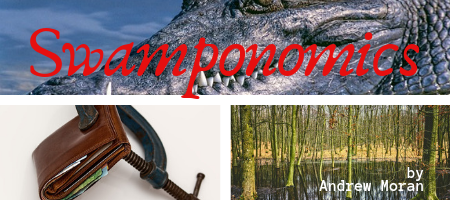Seeing Alan Greenspan
One of the most significant enablers of deficit-financed spending and price inflation in the United States has been the Federal Reserve. For years, the central bank has fueled reckless spending on Capitol Hill, while making the cost of living coast to coast more expensive for Mr. and Mrs. Smith on 123 Elm Street. You know, the house with the white picket fence, two kids, and a dog named Fido.
Former Federal Reserve Chair Alan Greenspan revealed that his two biggest economic concerns are inflation and the budget deficit. The former is set to explode with trillions in printed dollars, while the latter is poised to top $3 trillion by the end of 2020.
Speaking in his first televised interview since March, the “Maestro” was blunt and generally accurate: The federal government’s budget gap is “getting out of hand,” adding that “we know very little so we pretend a great deal.” He told CNBC:
“My overall view is that the inflation outlook is unfortunately negative, and that’s essentially the result of entitlements crowding out private investment and productivity growth. We are, if anything, underestimating the size of the budget deficits that are down the road.”
When asked for his thoughts on the U.S. central bank’s new inflation approach, Greenspan refrained from going too deep: “I don’t want to get involved and stick my nose in any of these things. I think that so far from what I can judge things are going well there.”
Greenspan has been doing well in his commentary in recent years, making Fed critics wonder: Where was this guy when he was at the helm of the world’s most powerful institution?
Do You Even Price Gouge, Bro?
It might have seemed like a lifetime ago, but do you remember the height of the Coronavirus pandemic? Stores were running out of toilet paper, you could not find hand sanitizer anywhere, and people were creative in how they were wearing face masks due to shortages of personal protective equipment.
Amazon ostensibly took advantage of the panic by allegedly charging inflated prices for disposable gloves, hand sanitizer, and soap says Public Citizen. The non-profit progressive consumer rights advocacy group accused the website of raising prices as much as 1,000% when compared to pre-pandemic-level costs.
The report listed 15 essential products that had considerable markups during the COVID-19 public health crisis. For instance, a pack of 50 disposable face masks increased by 1,000%. As another example, a pack of eight 1000-sheet toilet paper rolls increased by 528%. Even a one-pound box of Domino powdered sugar increased by 520%.
A spokesperson for Amazon denied that the e-commerce juggernaut price-gouged at the height of the outbreak.
“There is no place for price gouging on Amazon and that includes products offered directly by Amazon. Our systems are designed to offer customers the best available online price and if we see an error, we work quickly to fix it,” the company representative said in a statement.
If the allegations are true, Jeff Bezos and his online retail juggernaut were doing the only socially responsible thing. Price-gouging is a critical, essential, and humane function during a widespread panic, natural disaster, or some other society-altering event. By inflating prices, it achieves a couple of things. The first is that the profit motive incentivizes entrepreneurs and businesses to ramp up output so they can take advantage of the higher prices. The second is that it sends signals to producers as to what consumers are urgently demanding. The third is that it promotes the conservation of essential goods since you are more likely to either buy what you need or be careful in how you utilize the items you purchase. Both sides benefit from the trade.
Plus, imagine if price-gouging were prevalent in March, more people would have access to masks. And, if health authorities are right about the efficacy of face coverings, then there might be fewer deaths and infections today.
Wearing Shorts on Wall Street
Nikola Corporation has been one of the hottest stocks on Wall Street this year as it attempts to bank on the zero-emissions craze. The company has been on a tear this year on the Nasdaq Composite Index, skyrocketing more than 500% at its peak in June. It has since pared its gains, trading at around $40 a share. But there might be something fishy occurring at one of Tesla’s chief competitors, warns a prominent short-seller.
Hindenburg Research accused the electric truck manufacturer of being an “intricate fraud” that had been constructed on a foundation of lies by Trevor Milton, its founder and executive chairman. According to the report:
“We have gathered extensive evidence – including recorded phone calls, text messages, private emails and behind-the-scenes photographs-detailing dozens of false statements by Nikola Founder Trevor Milton. We have never seen this level of deception at a public company, especially of this size.”
 The short-seller asserts that Nikola misled partners by presenting bogus claims about its technology. One of them is its hydrogen fuel cell batteries that never existed, charges Hindenburg. Nikola, Hindenburg says, is planning to get out of this mess by relying on General Motors’ battery technology after recently signing a multi-billion-dollar deal.
The short-seller asserts that Nikola misled partners by presenting bogus claims about its technology. One of them is its hydrogen fuel cell batteries that never existed, charges Hindenburg. Nikola, Hindenburg says, is planning to get out of this mess by relying on General Motors’ battery technology after recently signing a multi-billion-dollar deal.
Nikola has denied the allegations, telling MarketWatch that the firm “has been vetted by some of the world’s most credible companies and investors.” But the denial was not enough for investors as shares plummeted more than 11% during the September 10 trading session.
Has the Nikola spike run out of energy? If so, Nikola might echo Elon Musk’s mantra of “burn the shorts!” And this is why short-sellers are important because they identify possible shenanigans.
~
Read more from Andrew Moran.



